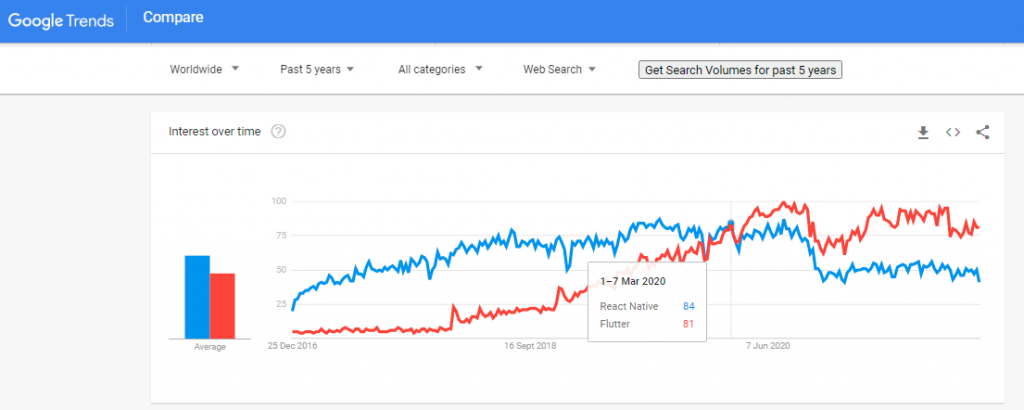Need to develop an app for iOS and Android that is cost-effective, faster to market, features packed with rich user experience and an easy development process? Enter Flutter. Flutter needs no introduction in the world of mobile app development. The Google-backed open-source software development kit is based on the DART programming language. Ever since its inception back in 2017, it has been one of the fastest-growing and widely popular mobile app development platforms.
Stats Proving Flutters Popularity
- Flutter is the most popularly used cross-platform mobile framework globally amongst developers, according to a 2021 developer survey conducted by Statista. In 2019, only 30 percent of developers were using Flutter, which rose to 42% by 2021. (Source)
- Google’s Flutter hit a 2 million user milestone just 16 months after its release.
- Flutter has an impressive clientele with some of the most globally recognized enterprises like BMW, Alibaba Group, eBay, Dream 11 and more.
- There are 110,835 tagged Flutter questions on StackOverFlow.
Why is Flutter the leading Cross-Platform Development SDK
Cross-platform development has skyrocketed to match the ever-rising demand for mobile apps across all industries as it eliminates the effort, time and cost of developing different apps for different platforms. With a single codebase, a cross-platform app can run across various devices and platforms.

Prior to the first Flutter stable release, React Native was the go-to cross-platform framework that was widely popular among developers and clients alike. While React Native still holds a considerable market share, it has started to decline while Flutter is on the rise.
What makes Flutter so much better than most other available options out there like React Native and Ionic? These top features make developers choose Flutter for cross-platform development.
Hot Reloading
Traditionally, in most mobile app frameworks, the developers needed to wait a few minutes to see the effect of their code reflected on the screen to understand what output their input created. To make this faster and more efficient, Flutter came with its Hot Reload feature, allowing developers to render changes almost in real-time as they make the changes in the code. This exceptional feature reduces development time, costs and efforts while providing a seamless programming experience for the developers.
Flutter is also a widget-based SDK and uses Dart Virtual Machine that makes a widget tree. Hence, when you make changes to a particular aspect of your Flutter app, only the code that has relevance to that task gets affected while the current state of the overall app is preserved. This helps developers test the effects of their change without having to worry about the change affecting any stimulator, hardware or emulator.
Lesser Coding
Flutter is based on the Dart programming language by Google which is strongly typed and object-oriented. Flutter follows a declarative and reactive programming style. JavaScript Bridge is not needed with Flutter development; the app startup time is better optimized. And since Dart supports multiple platforms, the same written code is used to develop mobile, desktop and PWA apps.
Ready to use Widgets
Flutter has a massive repository of customizable widget kits that simplifies developing any app of any complexity and type. Flutter widgets are reliable, extensible and fast. They also work well with Material and Cupertino, making the entire process faster and easier.
Native like App Development
One of the most significant reasons behind Flutter’s popularity is its native-like app performance and visuals. Flutter uses an internal graphics engine called Skia that enables fast and optimized performance compared to many other mobile app frameworks. Since Flutter doesn’t reply to any code interpretations or representations, most times Flutter apps are indistinguishable from native apps.
Flutter’s Rendering Engine
The most common complaint or limitation of cross-platform app frameworks is that the app for Android and iOS looks exactly the same. However, there are companies that need to use Material You for Android and Human Interface Guidelines for iOS. Flutter has its own rendering engine with a set of reliable and efficient custom widget packages for both operating systems.
Suitable for MVP Development
Flutter is ideal for creating a basic MVP that outlines the basic functionalities and features of any application. MVPs built with Flutter are compatible with various platforms and are known to deliver a rich user experience. Hence, if you need an MVP to appeal to investors for investing in your app idea, Flutter is your ideal choice.
Lesser Testing
Apps built on other cross-platform development frameworks need to be tested on multiple platforms, which takes a lot of time and effort. Flutter uses a single codebase with no changes across all devices and platforms. Hence, apps made with Flutter need to be only tested once, which saves a lot of valuable time and cost of the development process.
Why Flutter Development is the Best Choice for Start-ups?
As per Google, 35% of Flutter developers work in start-ups, 26% in the enterprise, 19% are self-employed and 7% work with design agencies. Naturally, this indicates that many start-ups prefer Flutter over React Native and other cross-development platforms for developing their app. Here are some reasons Flutter is the future for start-up app development market –
- Flutter fits right into the budget of mobile app development that start-ups can afford.
- Flutter is open-source, which helps reduce or eliminate the licensing cost and other such expenses.
- Flutter supports the latest reactive frameworks.
- It can be easily integrated with your legacy/existing applications.
- Flutter works as a full-stack app solution from development to final deployment.
- Flutter has a rich library of ready-to-use widgets to match different business requirements.
- It is the best tool for integrating localization into your startup app.
- Flutter is proving to give intense competition to native applications with its smooth programming and interface.
- Flutter supports various credible IDEs like Xcode, Android Code and Visual Studio Code.
- Less time and money spent on testing as Flutter uses a single codebase for all platforms, hence it needs to be tested only once with a lesser risk of bugs.
Popular Apps Built with Flutter
Flutter has an impressive list of clientele in the Flutter Showcase section of their website, from automobile giants like BMW to eCommerce leaders like Alibaba Group, social media apps like Instagram and much more. Here are some of the top apps built with Flutter that show the true capability and range of Flutter development.
1. Xianyu by Alibaba
Category – Ecommerce Apps
This app by Alibaba Group is one of the most popular wholesale marketplaces for global trading. It uses Flutter for powering some important parts of the app. With Xianyu, you can buy products from global suppliers all at once from a single mobile app.
2. Pairing
Category – Dating Apps
Pairing is a social matchmaking app that utilises the user’s real-world communities to make pairs or help users connect with their ideal matches. It is available on both iOS and Android and is built completely on Flutter.
3. Lunching
Category – Food Delivery App
Launching, as the name suggests, is a food delivery app that is based on Flutter’s new architecture. It comes with many useful features such as – creating an organization level order using a single app, enabling bulk payments and more. Flutter provides a consistent framework, enabling a rapid and seamless development process for both Android and iOS with smooth animations and a rich user interface.
How Flutter will guide mobile app development in 2022 and the future?
With all the promises Flutter has to offer in the current mobile app development niche and beyond to apps built for different platforms, we believe the active community behind Flutter is only going to make improvements and optimizations to shape Flutter as the most reliable mobile app framework for the future. While Flutter may not single-handedly hold a monopoly on the mobile app market, it would certainly be one of the most important platforms that cannot be ignored. Here are some of our possible predictions for the changes and improvements in Flutter for the future –
Flutter Predictions for 2022 and beyond…
- Dart will most likely introduce a Null Safety feature migration of any file system within the Flutter ecosystem.
- The overall ergonomics and performance of embedding Flutter in existing Android and iOS apps will improve significantly.
- Flutter app quality will improve with dedicated and skilled efforts on improving application download size overhead, battery consumption, runtime performance and memory usage.
- Better quality support will be made available for platforms like macOS, Linux, Windows and the web.




